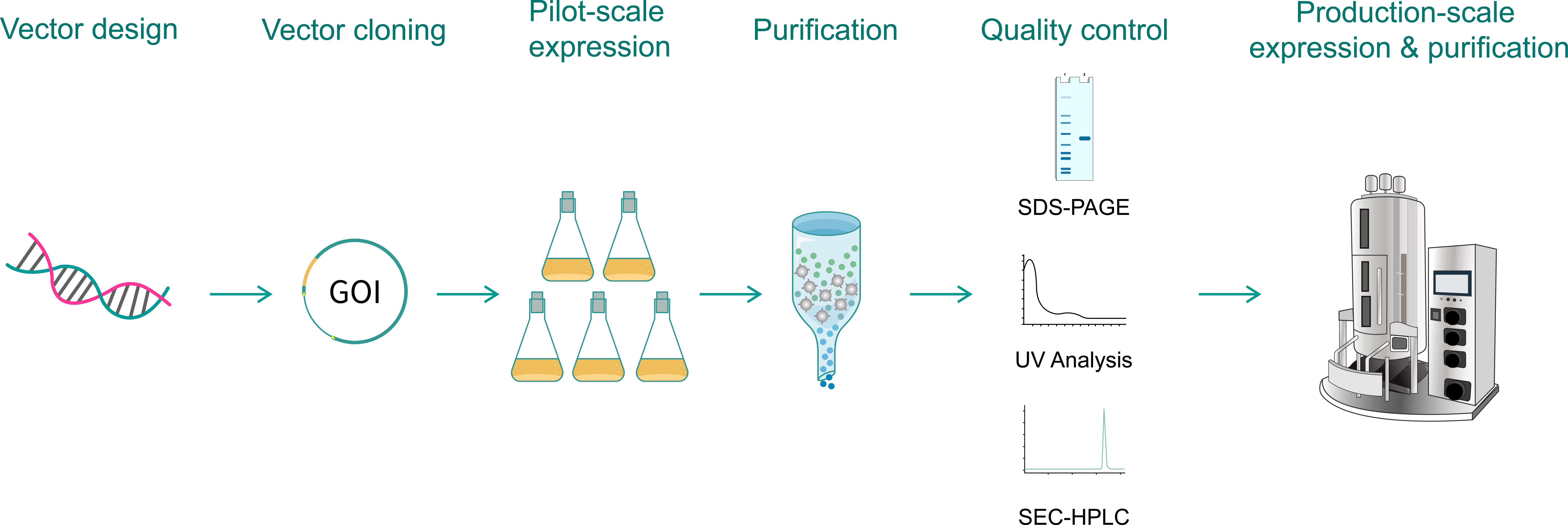Recombinant Protein Expression
VectorBuilder offers customized recombinant protein production services, employing multiple expression platforms suitable for various applications, such as protein structure analysis, enzymatic assay development, drug discovery, diagnostics, and bioengineering. Our protein production process is highly optimized for generating high-quality recombinant proteins utilizing our custom recombinant protein expression vectors. Additionally, we can produce recombinant proteins from customer-supplied vectors.
Highlights
- One-stop solution: from vector design all the way through to production-scale protein purification
- Comprehensive platform: flexibility to select from various expression systems
- Customization: freedom to add a variety of purification or detection tags on our highly intuitive vector design platform
- High performance: a broad range of purification methods and QC services are available to ensure high quality
Recombinant Protein Expression Systems
Workflow for Protein Production

How to Order
FAQ
All recombinant protein expression systems have their pros and cons which should be taken into consideration while selecting the optimal system for your project. The table below summarizes the pros and cons of each system.
| Recombinant protein expression system | Pros | Cons |
|---|---|---|
| Bacteria |
|
|
| Mammalian cells |
|
|
| Insect |
|
|
| Cell-free system |
|
|
Tags are frequently utilized for recombinant protein production. They streamline the purification process, and certain tags have demonstrated improvement in protein solubility, yield, or purity. If the tag is attached to the protease cleavage site, it can be removed after purification, and the efficiency of cleavage varies depending on the target protein. The careful selection of an appropriate tag is crucial for downstream protein expression and purification. The table below provides an overview of commonly used tags along with their advantages and limitations.
| Tag | Commonly applied system | Advantages | Limitations |
|---|---|---|---|
| GST | Bacteria, insect |
|
|
| His | All |
|
|
| SUMO | Bacteria, insect |
|
|
| Flag | Mammalian cells, insect |
|
|
| MBP | Bacteria, insect |
|
|
| Fc | Mammalian cells, insect |
|
|
For more information regarding tags, please visit protein tags.
All vectors cloned by VectorBuilder come with a 100% sequence guarantee. All recombinant proteins produced by VectorBuilder undergo stringent quality control. Default QC for most systems includes 1) validation of the protein expression vector by restriction digestion analysis and Sanger sequencing; and 2) determination of protein concentration and purity by A260/280 measurement and SDS-PAGE. Common additional QC services are shown in the table below, which can be provided upon request.
| Additional QC services | Method |
|---|---|
| Endotoxin test | LAL |
| Protein characterization | Western Blot |
| Intact MS (reduced) | |
| SEC-HPLC | |
| SEC-MALs | |
| Protein N-terminal sequencing | |
| Host cell protein test | |
| Tag removal | Protease digestion |
| Kinetics and affinity analysis | Octet |
| Biacore | |
| Pathogen testing panel for rodents | |
Please inquire about other QC services.
VectorBuilder offers a wide range of protein purification methods, including size exclusion chromatography (gel filtration), affinity purification, ion exchange chromatography, and hydrophobic chromatography. For His-tagged or GST-tagged recombinant proteins, affinity chromatography is typically included, while for tag-free recombinant proteins, size exclusion chromatography (gel filtration) is typically included. The selection of the purification method(s) will be determined based on the construct design and protein characteristics.








